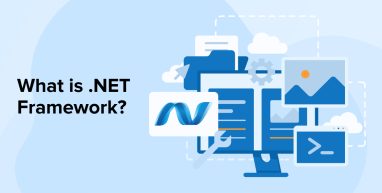
The .NET framework has become a reliable and high-performing tool, not just because it’s a product of Microsoft, but also due to a large and dedicated community that frequently contributes to improving its architecture. Because it offers various programming environments, top .NET development companies leverage it to deliver different types of software solutions including cloud infrastructure support, desktop applications, and web-based services.
Now, what is it that makes this framework so special? Well, this article acts as a comprehensive guide to understanding the .NET framework. It explains its functionality, architecture, components, benefits, use cases, and more. Read on to familiarize yourself with the framework and learn how to use it to your advantage.
1. What is .NET Framework?

The .NET framework is a software development framework developed by Microsoft, that is used for building and running applications that can run on the Windows platform. It is used to develop web-based, mobile-based, console-based, and form-based applications. It comes with a variety of tools and libraries that can help you build apps.
The .NET is an object-oriented framework similar to Java. but it is not platform-independent like Java. However, it does support multiple programming languages such as VB.NET, Visual Basic, and C#.
1.1 How the .NET Framework Works?
Various programming languages like C# and F# are used to create .NET applications. They are compiled into Microsoft Intermediate Language or Common Intermediate Language. This bytecode is then translated into machine code for its effective execution. The .NET framework also provides many runtime hosts, including a few from third parties.
In addition, it ensures that the coded components are integrated well with the other codes. Even if the code is developed by a trusted third party or an unknown party, it can execute the code effectively. The .NET framework is skilled at addressing performance issues in a scripted or interpreted environment.
1.2 Advantages of .NET Framework Architecture
The question of selecting a .NET framework for app development is straightforward due to the wide range of benefits it offers. Some of them are mentioned below:
- Secured: Using the .NET framework means building a secure application. It provides various security features like encryption, role-based protection, access management, and more. This helps protect your app from malicious attacks and unauthorized access. It also offers garbage collection which helps reduce the risks of memory leaks.
- Object-Oriented: Each element of the framework is called an object. The entire .NET framework is built upon various logical objects. It allows building, modifying, and managing the objects to perform specific tasks or processes. Such a modularity gives great flexibility, and productivity and is very helpful in finding and solving problems quickly.
- Easily manageable: Using and maintaining the .NET framework is very easy. The framework is open-source, so both its source code and HTML code are available. Moreover, it also allows the source code to run on the server, making web pages more flexible and robust.
- Feature-Rich: .NET is a preferred option for developers looking to build a dynamic application. The open-source framework consists of a very vast ecosystem of tools and libraries. This means you get access to a variety of features like drag-and-drop controls, automatic deployment, and more.
- Monitoring: The .NET framework provides the option of automated monitoring and automated control is also given to the system. When any issues like memory leaks are found, it will automatically stop the affected process. Once the issues are resolved, the processes will be resumed automatically.
1.3 Uses of .NET Framework
Microsoft developed a versatile framework in the form of the .NET. There are multiple use cases for this open-source app development framework including:
- Games: Being a flexible framework greatly helps .NET in the creation of gaming applications. Additionally, .NET is a responsive and high-performing framework, which is extremely helpful in developing games and maintaining them for the long term.
- AI and ML: The .NET ecosystem offers ML.NET framework and Microsoft Cognitive Services. Both of these are leveraged for their AI/ML capabilities. They come with built-in trained models, tools, and APIs that allow you to design as well as incorporate smart features such as NLP, computer vision, and automated recommendation systems.
- IoT: Developing bespoke IoT applications and connecting them with smart devices has now become easier, due to the interoperability of the .NET framework. Visual Studio can help you out with designing, distributing, and debugging the code in those smart devices. The .NET foundation supports this tool along with several other tools that are suitable for IoT projects.
- Cloud-based applications: Due to its high compatibility, you can integrate the .NET framework with the cloud services as well. Although Microsoft has its cloud services namely Microsoft Azure, the entire process will be seamless. This enables you to create highly scalable and secure cloud-based apps.
2. Layers of .NET Application Architecture
The .NET application usually consists of a 3-tier architecture. This means that the apps created using the .NET framework have three layers of architecture. They are:
2.1 Presentation Layer
This is the top layer of the architecture that focuses on user interfaces and user interactions. The presentation layer ensures that your user interface is responsive and visually appealing.
The presentation layers consist of all UI/UX components, elements, and controls. It also contains forms and windows that present data to the users to help them understand the tasks.
2.2 Business Logic Layer
As the name suggests, this layer consists of the app’s business logic along with all the rules and workflows that determine how to process and handle the data across all layers.
The business layer serves as middleware connecting the data layer and the presentation layer. It helps implement calculations and commands and make logical decisions.
2.3 Data Access Layer
All the interactions with the database or data storage systems are carried out by the data layer. It is a medium that connects the business layer to the data source. It allows the app to perform various operations on the database such as INSERT, UPDATE, DELETE, and more. The data layer helps developers in maintaining the security and integrity of the data.
3. Key Considerations About .NET Framework
The two key components in the .NET framework architecture are:
3.1 Common Language Runtime
Common Language Runtime is an engine that provides an environment to run .NET apps. It is responsible for executing the .NET app code by compiling it into machine code. This allows the processor to execute it easily. Some of the features of CLR include Exception handling, type safety, garbage collection, automatic memory management, and more.
3.2 Framework Class Library
The .NET Framework Class Library offers a wide range of pre-built APIs, services, and functionalities. It also provides various value types, namespaces, interfaces, and classes that can be used in .NET applications. The robust development tools and IDEs like Visual Studio from FCL allow you to build server, web-client, and GUI applications.
4. Considerations for the .NET Framework

Most developers must be aware of the .NET framework and its features. So, here in this blog, you will see a quick run-through of how these features contribute to building a top-notch .NET developed application. Let’s get into the details of what these features of the .NET framework add to the .NET application you develop.
4.1 Free and Open Source
During its initial release in 1990 under a different name of NGWS, the framework was closed source. But in 2014, the .NET was declared to be open-source. This means it’s free to use and distribute. Being open-source allows you to share the code or the entire project with the vendors, shareholders, and associates.
Moreover, open-source frameworks allow collaboration and agile development. This also helps to reduce your product’s time-to-market as well. It is also easy to get help from the community when working on open-source projects.
4.2 Supports Multiple Development Paradigms for Web Development
People may be unaware of how the .NET framework supports different programming languages. .NET also offers the ability to use the code of one language within the code of another, which opens up new possibilities. As .NET is a unified platform, it can be easily integrated with all the standard web development platforms.
In general, there are several methods and developer tools for web development. ASP.NET offers three approaches to web development to accommodate users with varying goals and skill sets. WebForms caters to those who have a strong understanding of WinForms and have medium to advanced expertise in RAD, whereas MVC caters to people who want complete control over HTML and have knowledge of frameworks such as Ruby on Rails.
4.3 Supports for Mobile Application Development
You can now create mobile applications using robust, cross-platform .Net frameworks such as Xamarin and Xamarin.Form. With .NET, you can reuse the code across multiple platforms such as Android, iOS, MacOS, Windows, and more. Development time is reduced by reusing code across different platforms.
The .NET framework has an extensive ecosystem of tools and libraries with a wide range of pre-built functionalities. It also offers a development environment like Visual Studio. Xamarin can easily integrate with these IDEs. Moreover, if you are targeting a specific platform, .NET also allows you to configure the SDKs. Using .NET enables you to streamline your mobile app development process.
4.4 Dot Net Has a Wider Scope
The term .NET technology refers to a broad umbrella that encompasses a wide range of programming languages like C#, F#, and Visual Basic, as well as developer tools such as Visual Studio (an integrated development environment), and Visual Studio Code. They also provide best-in-class IDEs for custom .NET app development. Microsoft, as a well-known global service provider, has established a methodical development eco-system for .NET application development, quality assurance, reengineering, and migration.
The .NET framework is language-independent. It is compatible with all common computer programming languages and operating systems, which keeps it within the .NET ecosystem. If we talk about Interoperability in the Dot Net framework then it may be classified into three types:
- Interoperability of .NET with COM components.
- P/Invoke – it shows how .NET interacts with Win32 DLLs.
- .NET interoperability- how COM components work in a .NET environment.
In the above section, COM stands for Component Object Model and Microsoft established it as a binary-interface standard between two binary modules. One of these is a .NET standard library, and the other is a user-run application. It specifies how these two binary modules should meet and interact with one another.
The term “forward compatibility” refers to the ability to access dot net components from COM components using the .NET runtime. Similarly, if the .NET runtime allows access to the old COM Code of the .NET components, then it is termed backward compatibility.
4.5 Storage of Previous Application Versions
While third-party software should generally be compatible with current .dll and .exe files produced in .NET, there are times when this is not the case. For example, the software will work on that computer system if the supportive file extension of an application does not match. The .NET platform is useful in these situations since it stores all previous versions of the .NET code on its software development platform. Or, at the very least, multiple versions that the .NET developer wishes to save.
As a result, a .NET developer can collaborate with a company’s IT staff to install an earlier version of the program so that the software can be installed. They can also make changes to a .exe or .dll file to avoid future issues.
The below image shows the previous versions of .NET framework with its release date.
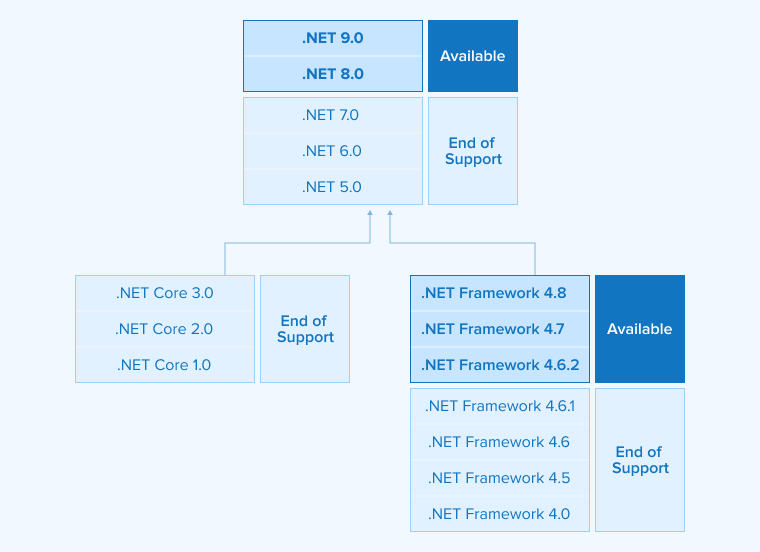
5. Top Three Main Application Models of .NET Framework
The .NET Framework, released in 2002, stands as the first oldest .NET implementation. Dot Net framework includes three main application models – WPF, Windows Forms, ASP.NET Forms, and Base Class Library.
Windows Presentation Foundation (WPF):
It is a UI framework used for designing graphical user interfaces primarily for desktop customer applications on Windows OS. WPF practices the aptitudes of Extensible Application Markup Language (XAML).
Windows Forms:
Windows Forms allow businesses to develop feature applications that are scalable, and easy to deploy.
ASP.NET:
ASP.NET is applied to develop forms-based applications, dynamic websites, and web applications. It is the Common Language Runtime (CLR) in its center that allows developers to compose ASP.NET code practicing different .NET languages.
Base Class Library (BCL):
BCL gives the most basic functions such as classes in namespaces and is the center of the Framework Class Library (FCL), a kit of reusable interfaces, properties, and value standards that are firmly integrated with the Common Language Runtime (CLR). The combination of FCL and CLR creates the .NET Framework. The base class library also includes ADO.NET, database interaction technology used by developers to obtain databases.
As Dot Net Framework maintains only Windows-based tools, there was a requirement for a cross-platform combination.
6. .NET Framework Design Principle
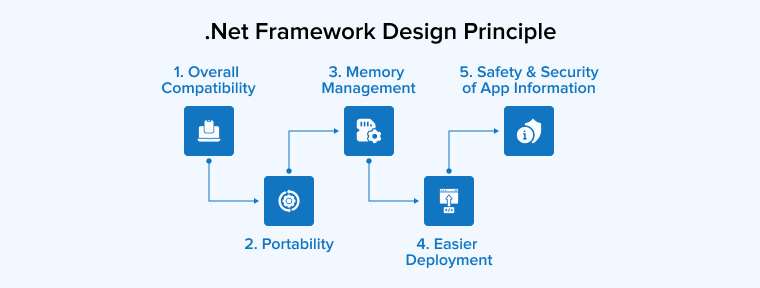
Now, it’s time to understand the design principles of the .NET framework. You must know what you are creating and what you are utilizing as aspects.
6.1 Overall Compatibility
.NET Framework is a backward compatible framework where .NET framework 4.5 and later versions are compatible with the applications built with older versions. This ensures Microsoft guarantees that older framework versions work nicely with the latest version with each release.
6.2 Portability
Another important aspect of this is portability. Applications created with the .NET framework can run on any Windows platform. Microsoft is also considering making portable platforms that run on other platforms such as iOS and Linux, in recent years. It is also possible to combine and contrast code written in the various framework-supported languages.
6.3 Memory Management
The Common Language runtime manages all memory. The .NET framework includes the ability to see resources that aren’t currently being used by a running program. It would then release those resources to the situation. This is accomplished with the help of a program named “Garbage Collector,” which is part of the .NET framework. The trash collector runs at regular intervals, looking for unused system resources and freeing them as needed.
6.4 Easier Deployment
The .NET framework provides tools for packaging applications developed with it. After that, these packages can be distributed to client computers. The program would then be installed by the packages.
6.5 Safety & Security of App Information
The .NET framework provides an inbuilt security facility that validates as well as verifies the entry of any bugs or flaws. Every aspect of the application requirements is thoroughly documented and managed for security reasons.
7. Conclusion
In this insightful blog, we have curated all the points that make the .NET framework a key differentiating technology for businesses. Many businesses, development teams, and analysts get confused and are not sure of what to choose between the available technologies like .NET or Java. So, here’s an eye-opener for them to understand why to chose the .NET stack and how it is secure and compatible compared to other software development technologies. The storage, interoperability, and specific architectural build-up are some of the strong reasons why businesses choose .NET.
FAQ
What is C# and .NET Framework?
C# is a type-safe and strongly typed programming language that includes automatic memory management and integrated concurrency. Meanwhile, .NET is a framework that can help you build highly secure and reliable applications to run on the Windows platform.
What are the 4 major features of the .NET Framework?
Some of the most important features of the .NET framework include a Common Type System, Cross-Language Interoperability, Automatic Resource Management, and Framework Class Library.
What is .NET used for?
The .NET is a robust framework used for developing web services, mobile, and desktop applications that can run on any platform. It consists of a large ecosystem of tools, languages, and libraries that can take your software development game to another level.


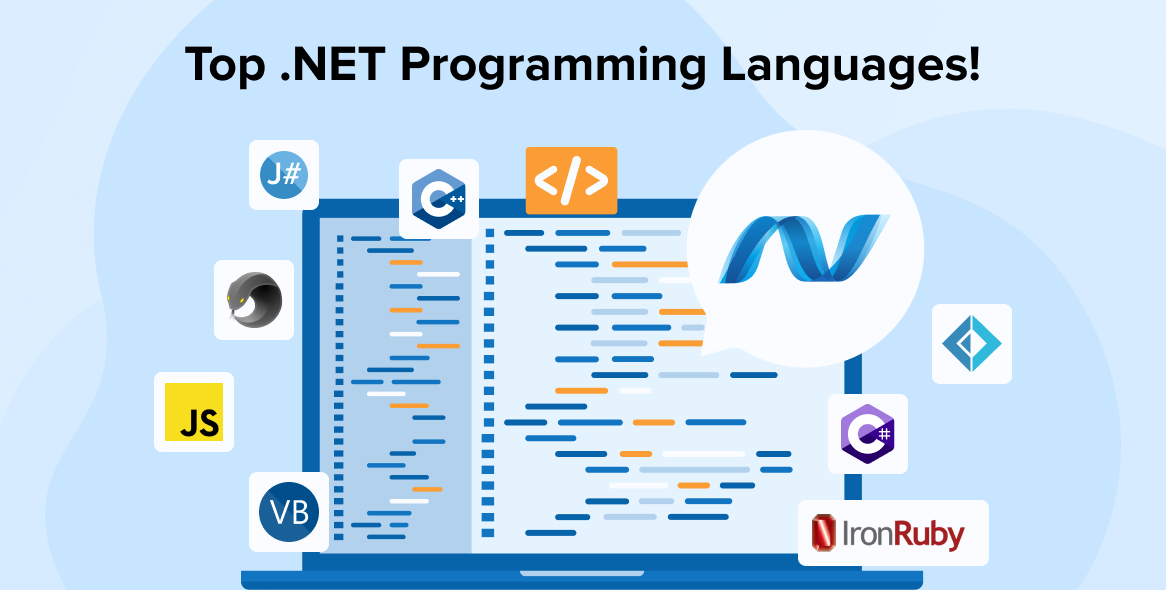
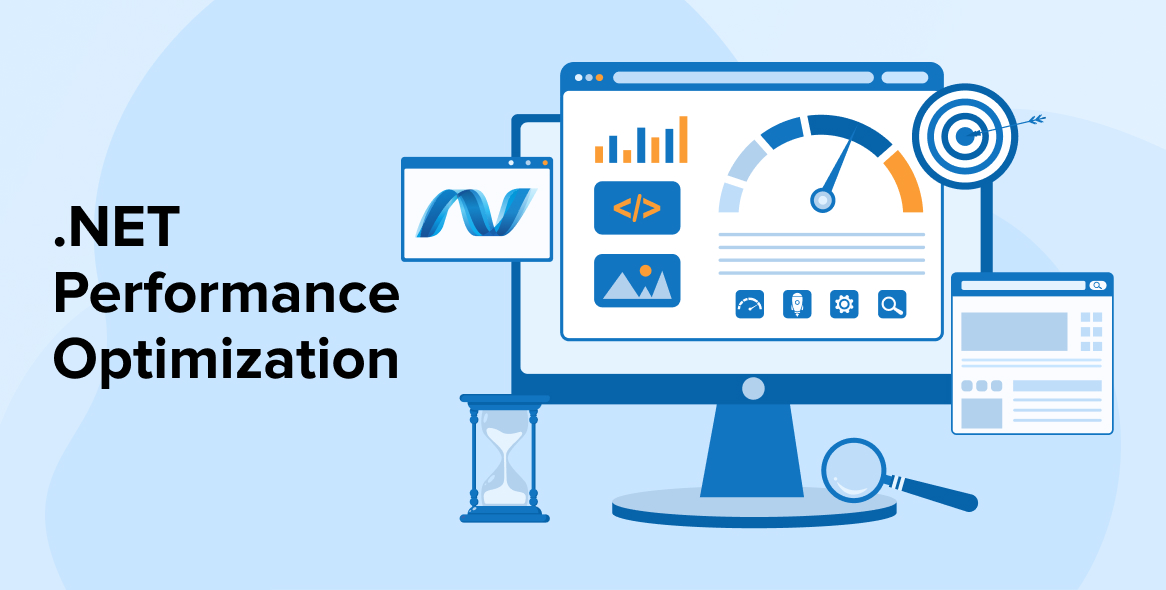
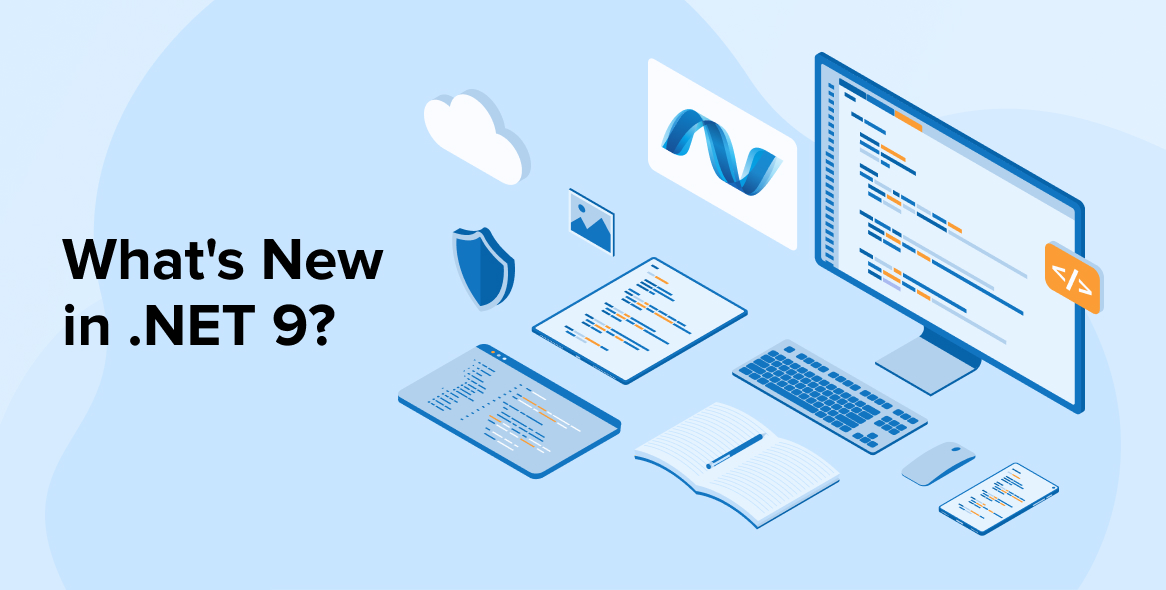

Undoubtedly .NET is the best framework so far which was introduced in 2002 and backed up by the industry giant i.e Microsoft. Also, .NET supports 60 programming languages. It supports various industry standards and provides a wide list of features and functionalities which has made .NET a most chosen framework by businesses for their software solutions. Thanks, writer this was an up to point blog. Enjoyed reading it!!
.NET is the best ecosystem for developing a variety of web and desktop applications. Being a .NET developer I must say that this blog has mentioned all the significant points of .NET for a wannabe .NET developer or the businesses who are looking forward to getting custom software developed using .NET. However, including information on when to go for the .NET framework will help developers to know when to suggest the .NET framework to their clients after studying their software requirements.
A framework designed and developed by the industry giant- Microsoft is worth a read. I am a student of a computer science field and deciding which framework or technology to learn for my career in the software development industry. Thank you so much for this well-drafted article. It has helped me a lot!
.NET is the most loved software development framework not only by developers but also by business owners as they trust it more for security reasons. The .NET framework has a variety of features to develop a variety of web apps and software solutions. I really liked the way the information is presented in the blog. I would definitely share this blog with my teammates.